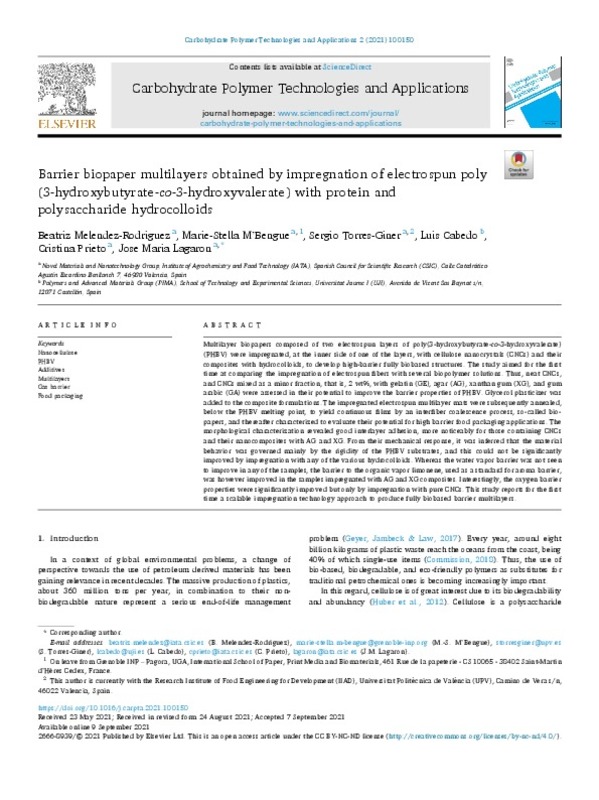JavaScript is disabled for your browser. Some features of this site may not work without it.
Buscar en RiuNet
Listar
Mi cuenta
Estadísticas
Ayuda RiuNet
Admin. UPV
Barrier biopaper multilayers obtained by impregnation of electrospun poly(3-hydroxybutyrate-co-3-hydroxyvalerate) with protein and polysaccharide hydrocolloids
Mostrar el registro sencillo del ítem
Ficheros en el ítem
| dc.contributor.author | Melendez-Rodriguez, Beatriz
|
es_ES |
| dc.contributor.author | M'Bengue, Marie-Stella
|
es_ES |
| dc.contributor.author | Torres-Giner, Sergio
|
es_ES |
| dc.contributor.author | Cabedo, Luis
|
es_ES |
| dc.contributor.author | Prieto, Cristina
|
es_ES |
| dc.contributor.author | Lagaron, Jose Maria
|
es_ES |
| dc.date.accessioned | 2022-03-08T19:03:32Z | |
| dc.date.available | 2022-03-08T19:03:32Z | |
| dc.date.issued | 2021-12-25 | es_ES |
| dc.identifier.uri | http://hdl.handle.net/10251/181315 | |
| dc.description.abstract | [EN] Multilayer biopapers composed of two electrospun layers of poly(3-hydroxybutyrate-co-3-hydroxyvalerate) (PHBV) were impregnated, at the inner side of one of the layers, with cellulose nanocrystals (CNCs) and their composites with hydrocolloids, to develop high-barrier fully biobased structures. The study aimed for the first time at comparing the impregnation of electrospun fibers with several biopolymer solutions. Thus, neat CNCs, and CNCs mixed as a minor fraction, that is, 2 wt%, with gelatin (GE), agar (AG), xanthan gum (XG), and gum arabic (GA) were assessed in their potential to improve the barrier properties of PHBV. Glycerol plasticizer was added to the composite formulations. The impregnated electrospun multilayer mats were subsequently annealed, below the PHBV melting point, to yield continuous films by an interfiber coalescence process, so-called biopapers, and thereafter characterized to evaluate their potential for high barrier food packaging applications. The morphological characterization revealed good interlayer adhesion, more noticeably for those containing CNCs and their nanocomposites with AG and XG. From their mechanical response, it was inferred that the material behavior was governed mainly by the rigidity of the PHBV substrates, and this could not be significantly improved by impregnation with any of the various hydrocolloids. Whereas the water vapor barrier was not seen to improve in any of the samples, the barrier to the organic vapor limonene, used as a standard for aroma barrier, was however improved in the samples impregnated with AG and XG composites. Interestingly, the oxygen barrier properties were significantly improved but only by impregnation with pure CNCs. This study reports for the first time a scalable impregnation technology approach to produce fully biobased barrier multilayers. | es_ES |
| dc.description.sponsorship | This research work was funded by the H2020 EU project USABLE PAKAGING (reference number 836884) and by the Spanish Ministry of Science and Innovation (MICI) project RTI2018-097249-B-C21. Ms. Beatriz Melendez-Rodriguez would like to acknowledge the MICI for her FPI fellowship (BES-2016-077972) and Dr. Torres-Giner for his MICI Juan de la Cierva¿Incorporacion contract (IJCI-2016-29675). The authors would also like to acknowledge the Unidad Asociada IATA (CSIC)-UJI in Polymer Technology. | es_ES |
| dc.language | Inglés | es_ES |
| dc.publisher | Elsevier | es_ES |
| dc.relation.ispartof | Carbohydrate Polymer Technologies and Applications | es_ES |
| dc.rights | Reconocimiento - No comercial - Sin obra derivada (by-nc-nd) | es_ES |
| dc.subject | Nanocellulose | es_ES |
| dc.subject | PHBV | es_ES |
| dc.subject | Additives | es_ES |
| dc.subject | Multilayers | es_ES |
| dc.subject | Gas barrier | es_ES |
| dc.subject | Food packaging | es_ES |
| dc.title | Barrier biopaper multilayers obtained by impregnation of electrospun poly(3-hydroxybutyrate-co-3-hydroxyvalerate) with protein and polysaccharide hydrocolloids | es_ES |
| dc.type | Artículo | es_ES |
| dc.identifier.doi | 10.1016/j.carpta.2021.100150 | es_ES |
| dc.relation.projectID | info:eu-repo/grantAgreement/AEI/Plan Estatal de Investigación Científica y Técnica y de Innovación 2017-2020/RTI2018-097249-B-C21/ES/ENVASE ACTIVO MULTICAPA TERMOCONFORMABLE DE ALTA BARRERA BASADO EN BIOECONOMIA CIRCULAR/ | es_ES |
| dc.relation.projectID | info:eu-repo/grantAgreement/MCIU//IJCI-2016-29675//Juan de la Cierva - Incorporación - Torres Giner/ | es_ES |
| dc.relation.projectID | info:eu-repo/grantAgreement/EC/H2020/836884/EU/ | es_ES |
| dc.relation.projectID | info:eu-repo/grantAgreement/Agencia Estatal de Investigación//IJCI-2016-29675//AYUDA CONTRATO JUAN DE LA CIERVA-INCORPORACION-TORRES GINER/ | es_ES |
| dc.relation.projectID | info:eu-repo/grantAgreement/MCIU//BES-2016-077972/ | es_ES |
| dc.rights.accessRights | Abierto | es_ES |
| dc.description.bibliographicCitation | Melendez-Rodriguez, B.; M'bengue, M.; Torres-Giner, S.; Cabedo, L.; Prieto, C.; Lagaron, JM. (2021). Barrier biopaper multilayers obtained by impregnation of electrospun poly(3-hydroxybutyrate-co-3-hydroxyvalerate) with protein and polysaccharide hydrocolloids. Carbohydrate Polymer Technologies and Applications. 2:1-9. https://doi.org/10.1016/j.carpta.2021.100150 | es_ES |
| dc.description.accrualMethod | S | es_ES |
| dc.relation.publisherversion | https://doi.org/10.1016/j.carpta.2021.100150 | es_ES |
| dc.description.upvformatpinicio | 1 | es_ES |
| dc.description.upvformatpfin | 9 | es_ES |
| dc.type.version | info:eu-repo/semantics/publishedVersion | es_ES |
| dc.description.volume | 2 | es_ES |
| dc.identifier.eissn | 2666-8939 | es_ES |
| dc.relation.pasarela | S\447110 | es_ES |
| dc.contributor.funder | European Commission | es_ES |
| dc.contributor.funder | Agencia Estatal de Investigación | es_ES |
| dc.contributor.funder | Ministerio de Ciencia, Innovación y Universidades | es_ES |
| dc.subject.ods | 12.- Garantizar las pautas de consumo y de producción sostenibles | es_ES |








